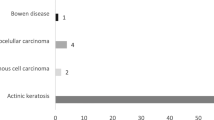Summary
Isolated tumors of epidermis with dyskeratosis and acantholysis of various degrees can be classified into three groups: a) Keratosis senilis (K.s.) with dyskeratosis of darier's type, b) so called warty dyskeratoma or dyskeratosis follicularis isolata and c) Carcinoma dyskeratoticum segregans (c.d.s.) as the malignant variety.
The own observation of a patient with so called warty dyskeratoma and the cases described in literature give evidence for a continuous transition between K.s. with Darier like atypia (D.a.) and c.d.s. as well as between K.s. with D.a. and warty dyskeratoma.
Instead of the term “warty dyskeratoma” we would prefer the word dyskeratoma segregans, since dyskeratosis and segregation prevail. No conclusion is possible whether warty dyskeratoma can develop into c.d.s. or has to be considered as a final state.
Zusammenfassung
Isoliert auftretende, mit unterschiedlich ausgeprägter Dyskeratose und Acantholyse einhergehende, epidermale Tumoren kann man in drei Typen einteilen: a) Keratoma senile (K.s.) mit Dyskeratose vom Typus des Morbus Darier, b) sog. warziges Dyskeratom oder Dyskeratosis follicularis isolata und c) Carcinoma dyskeratoticum segregans (c.d.s.) als maligne Variante.
Anhand eigner Beobachtung eines warzigen Dyskeratoms sowie der in der und zugänglichen Literatur beschriebenen Fälle konnten sowohl fließende Übergänge zwischen K.s. mit Darier-ähnlicher Atypie und Carcinoma dyskeratoticum segregans als auch zwischen K.s. mit Darier-ähnlicher Atypie und warzigem Dyskeratom aufgezeigt werden.
Statt “warziges Dyskeratom” möchten wir wegen der im Vordergrund stehenden dyskeratotischen und segregierenden Veränderungen die Bezeichnung Dyskeratoma segregans wählen. Es kann bis jetzt noch nicht mit ausreichender Sicherheit festgestellt werden, ob sich aus dem Dyskeratoma segregans ein Carcinoma dyskeratoticum segregans entwickeln kann oder ob es als Endzustand anzusehen ist.
Similar content being viewed by others
Literatur
Allen, A. C.: The skin: A clinicopathologic treatise, pp. 558–559. St. Louis: C. V. Mosby Co. 1954.
Apertenko, A. K.: Warty Dyskeratoma. Vestn. Derm. Vener. 42, 75–78 (1968); zit. aus Zbl. Haut- u. Geschl.-Kr. 125, 34 (1969).
Borelli, D.: Aspetti pseudoglandulari nell epithelioma discheratosico: “Adenoacanthoma of sweat glands” di Lever. Dermatologica (Basel) 97, 193–207 (1948).
Chorzelski, T.: Ein Fall von Übergang einer Keratosis senilis mit Dyskeratose vom Typ des Morbus Darier in ein dyskeratotisches Spinaliom. Hautarzt 14, 37–38 (1963).
Delacrétaz, J.: Dyskératose folliculaire localisée. Bull. Soc. franç. Derm. Syph. 68, 938–941 (1961); zit aus Zbl. Haut- u. Geschl.-Kr. 113, 45 (1962/63).
—: Dyskératomes verruqueux et Kératoses séniles dyskératosiques. Dermatologica (Basel) 127, 23–32 (1963).
—: Remarques sur un cas de dyskératose folliculaire isolée. Dermatologica (Basel) 132, 92–95 (1966).
—, Madjedi, A. S., Loretan, R. M.: Epithelioma spinocellular segregans. Hautarzt 8, 512–518 (1957).
Dubreuihl, K.: zit. nach: Tritsch, H.
Freudenthal, W.: Verruca senilis und Keratoma senile. Arch. Derm. Syph. (Berl.) 152, 505–528 (1926).
Freund, H.: Darierähnliche Atypie eines Keratoma senile mit Blasenbildung. Arch. Derm. Syph. (Berl.) 162, 733–738 (1930).
Furtado, T. A., Szymanski, F. J.: Étude histologique du dyskératome verruqueux. Ann. Derm. Syph. (Paris) 88, 633–640 (1961).
Gans, O.: Histologie der Hautkrankheiten, 1. Aufl., Bd. II, S. 376. Berlin: Springer 1928.
Gorlin, G. J., Peterson, W. C.: Warty dyskeratoma. A note concerning its occurrence on the oral mucosa. Arch. Derm. 95, 292–293 (1967).
Graham, J. B., Helwig, E. B.: Isolated dyskeratosis follicularis. Arch. Derm. 77, 377–389 (1958).
Grimmer, H.: Keratosis senilis dyskeratotica kombiniert mit Basaliom. (Histolog. Bildbericht Nr. 143). Z. Haut- u. Geschl.-Kr. 53, 37 (1964).
Helwig, E. B.: Seminar on the skin neoplasma and dermatoses. Proceedings of the 20th Seminar of the Amer. Soc. clin. Pathology, pp. 53–56 (1955).
Haustein, U. F.: Dyskeratotisches Keratoma senile und warziges Dyskeratom. Hautarzt 18, 198–303 (1967).
Hookey, J. A.: Keratoma senile and verruca senilis. Arch. Derm. 23, 946–959 (1931).
Hyman, A. B., Dreizin, D. M.: Darier's disease limited in the wall of a cyst. Dermatologica (Basel) 127, 309–316 (1963).
Jablonska, S., Chorzelski, T.: Dyskeratoma and epithelioma (carcinoma) dyskeratoticum segregans. Dermatologica (Basel) 123, 24–37 (1961).
——: Epithelioma presenting features of Darier's type dyskeratosis. II. Dyskeratotic epithelioma (carcinoma). Przegl. derm. 48, 195–200 (1961).
Kalensky, J., Stava, Zd., Trapl, J.: Isolated dyskeratosis follicularis. Čs. Derm. 35, 336–338 (1960); zit. aus Zbl. Haut- u. Geschl.-Kr. 199, 268 (1961).
Kellum, R. A., Haserick, J. R.: Localized linear Keratosis follicularis. Arch. Derm. 86, 450–454 (1962).
Korting, G. W.: Dyskeratoma lymphadenoides. Derm. Wschr. 146, 534–543 (1962).
Kuta, A.: zit. nach Haustein.
Lever, W. A.: Adenoacanthoma of sweat glands. Arch. Derm. Syph. (Chic.) 56, 157 (1947).
—: Histopathology of the skin. Ed. 4, pp. 501–502. Philadelphia: J. B. Lippincott Comp. 1961.
Montgomery, H.: Precancerous dermatosis and epithelioma in situ. Arch. Derm. Syph. (Chic.) 39, 387–408 (1939).
Montgomery, H.: Dermatopathology, Vol. 1, Hoeber Medical Division, p. 92 ff. New York: Harper & Row 1967.
Nikolowski, W.: Dyskeratosis follicularis isolata. Arch. klin. exp. Derm. 208, 174–180 (1959).
Paschoud, J. M.: Keratose senile avec atypie rappelant la maladie de Darier. Dermatologica (Basel) 124, 281–285 (1962).
Stamps, Ph., Lundberg, G. D.: Isolated dyskeratosis follicularis in the axilla. Arch. Derm. 96, 182–184 (1967).
Szymanski, F. J.: Isolated Darier's disease: Arch. Derm. 73, 606 (1956).
—: Warty dyskeratoma: A benign cutaneous tumor resembling Darier's disease mikroscopically. Arch. Derm. 75, 567–572 (1957).
Tritsch, H.: Beitrag zur Darier-ähnlichen Atypie des Keratoma senile (sog. warziges Dyskeratom). Arch. klin. exp. Derm. 210, 280–290 (1960).
Weise, H. J.: Epithelioma spinocellulare segregans (Delacrétaz) oder Adenoacanthom der Schweißdrüsen (Lever)? Z. Haut-u. Geschl.-Kr. 29, 46 (1960).
Author information
Authors and Affiliations
Additional information
Herrn Prof. Tappeiner zum 60. Geburtstag gewidmet.
Rights and permissions
About this article
Cite this article
Metz, J., Schröpl, F. Zur Nosologie des Dyskeratoma segregans (“Warty dyskeratoma”). Arch. klin. exp. Derm. 238, 21–37 (1970). https://doi.org/10.1007/BF00527101
Received:
Issue Date:
DOI: https://doi.org/10.1007/BF00527101




